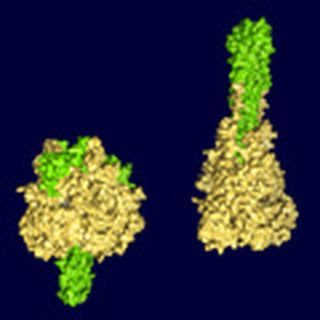 | BUFFALO, N.Y. -- Chemical engineers from the University at Buffalo have collaborated with scientists from other institutions to solve a critical bottleneck in the transport and capture of virus nanoparticles, making possible a device that could rapidly sample and detect infectious biological agents, such as viruses. High Resolution Image (507 KB JPEG). |
A paper describing the results was published in the March issue of Langmuir (vol. 23, p. 3840).
The rapid detection of viruses in biological samples is of increasing interest, particularly with the recent emergence of new viruses, including SARS, West Nile virus and avian flu virus.
But because viral particles are present at such low concentrations in biological samples, such as blood, a device that can quickly and easily detect them has remained elusive.
Typical procedures involve using passive diffusion to get the viral particles to bind to an antibody, a slow process that is not feasible for many applications, such as on the battlefield, where quick results are critical.
Scientists at the University of Wisconsin at Madison led by Nicholas L. Abbott, Ph.D., a co-author on the paper and John T. and Magdalen L. Sobota Professor of Chemical and Biological Engineering, previously had demonstrated that liquid crystals can amplify signals from low concentrations of viral particles, quickly indicating whether or not a virus is present on a surface.
"The bottleneck was how to transport and capture enough suspected viral particles onto a surface in a timely fashion so that they could be detected," said Alexandridis. "During the acute phase of an infection, the virus is at a very low concentration and relying on passive diffusion to deposit the viral particles onto the detection surface can be time-consuming."
The researchers wanted to speed up the collection of viral particles -- in this case, of vesicular stomatitis virus, a common animal virus -- at the right place on a substrate, while also doing it in media at physiological ionic strength.
The UB researchers used their expertise in a technique called directed assembly, in which they design external electrical and fluid flow fields in order to "drive" nanoparticles to specific locations and in specific concentrations on a substrate.
"This paper shows that by using electrodes separated by just a few micrometers together with electrothermally induced fluid flow, we can accelerate the transport of viral particles from aqueous suspensions with physiological ionic strength to specific points on a surface, allowing them to reach local concentrations high enough to allow subsequent rapid detection," Alexandridis explained.
"We achieved this not by accident, but by design," he continued. "We hypothesized that the application of these external fields would cause the nanoparticles to act in a certain way. We designed electrodes to generate the required forces for the system of interest and then put our design to the test."
In the research, the UB engineers used directed assembly to tailor dielectrophoretic forces, which act through a nonuniform electric field, overcoming an obstacle that occurs whenever nanoparticles are involved.
"When you work with microscopic objects dispersed in a liquid, gravity is very important," explained Alexandridis. "But at the nanoscale, gravity doesn't matter. So when you are trying to manipulate matter at the nanoscale, electrical fields and fluid fields may work best. By using directed assembly, we can tailor the forces acting on the nanoparticles. The ability to use several forces acting in tandem becomes important."
Electrical fields in particular, he said, are advantageous because by designing the electrodes in a certain way, engineers can control directionality and intensity of electrical forces acting on nanoparticles.
Alexandridis conducted the research with Aristides Docoslis, Ph.D., formerly a doctoral candidate and postdoctoral associate in Alexandridis' lab at UB and now the Canada Research Chair of Colloids and Surface Engineering at Queen's University at Kingston.
Additional co-authors are Luis A. Tercero Espinoza, Ph.D., of the Department of Chemical and Biological Engineering, University of Wisconsin at Madison; Bingbing Zhang, Ph.D., of Queen's University at Kingston, and Li-Lin Cheng, Ph.D., and Barbara A. Israel, Ph.D., of the Veterinary School of the University of Wisconsin at Madison.
The research was funded by a National Science Foundation grant in Nanoscale Exploratory Research and by the Gerald A. Sterbutzal Research Fund, administered by the UB School of Engineering and Applied Sciences.
The University at Buffalo is a premier research-intensive public university, the largest and most comprehensive campus in the State University of New York.
Contact: Ellen Goldbaum goldbaum@buffalo.edu 716-645-5000 x1415 University at Buffalo
Technorati Tags: nanofibers or Nanoscientists and Nano or Nanotechnology and nanoparticles or Nanotech and nanotubes or nanochemistry and nanoscale or The University at Buffalo or Virus Detector and biological agents or Biological Engineering and Nanotechnology Today or Public Domain Clip Art and Republican National Convention Blog














No comments:
Post a Comment